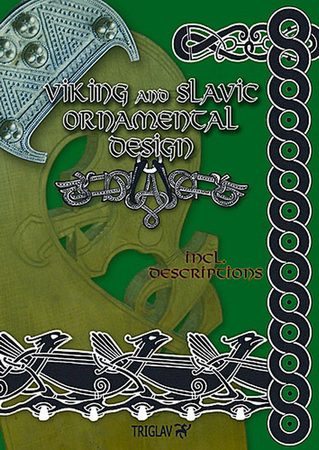After four years since the release of “Viking and Slavic Ornamental Design” volume one, the demand for our graphic collection did not decrease, subsequent editions, reprints and an English translation occurred. Historic re-enactors and enthusiasts of the Viking Age in many countries consumed the dish that we have prepared and demand more. Thus we present 258 new, yet old designs.
Selection of patterns was executed following the example of the first edition, but vol. 2. contains two thematic groups. The first one is a collection of redraws of stunning reliefs accumulated on only two objects, mainly the so called Kamień and Bamberg reliquaries, which are justly considered masterpieces. The form of the second group is much simpler, yet symbolically richer, it consists of simple representations of gods and other creatures from the Slavic and northern-Germanic mythology of the Viking Age.
Se pueden pedir en asatru-shop
| Viking and Slavic Ornamental Design(with Rus add-on)As an author and publisher, I would like to offer you a new book, "Viking and Slavic Ornamental Design. Graphical Catalogue with Rus Add-On." - a catalogue of 343 authentic graphic designs in 2D. Collated mainly from the Viking Age but in some cases later (C8th-C12th), they are sourced not only from Scandinavia, but also from Germany, Central Europe (eg. Wolin) and Russia. They've been drawn from a vast selection of artifacts - hilts, crossguards, pottery, jewellery, manuscripts, bone and wood carvings etc. Each and every pattern has an English description with its date, origin, place it was found, and meaning, where possible). MATERIAL SELECTION All of the graphics presented in this catalogue have one common denominator. All of them can be traced back to the Early Middle Ages, the period in European history beginning with the Great Migration (V-VI c.) until the end of XII c., when the European continent finally saw the feudal system being developed into a fully functional entity, recognized as a feature of the Middle Ages proper. During that time, a variety of ethnics and nations were shaped, some of which belonged to "barbarian" culture, especially among European tribes that remained in contact with Ancient, Mediterranean culture widely spread in Western Europe. Therefore, a different, geographical aspect of the presented material ought to be taken into consideration, aside from the period in which the imagery occurred. Accordingly, the imagery of choice for this particular catalogue is the one originating in Central, Eastern and Northern Europe, that is a region which was the last to enter a sphere of influence of the Roman Catholic (or Orthodox as was the case with Rus) Christianity, thus retaining its genuine, pagan character. THE RECIPIENT The catalogue is intended for artists and researches alike, people genuinely interested in old cultures, designers, digital artists, tattooists and people inspired by aesthetics of the Early Middle Ages. We expect that the booklet will also gain popularity among historical re-enactors, looking for new, uncommon motifs to decorate their Slavic or Viking outfit, the group to which the author himself belongs to and is thus well acquainted with difficulties involving interesting decoration of historical garments, furniture and leatherwork. These and other problems inspired creation of this catalogue, with an intention to ease life of modern warriors and promote more variety in ornamentation as well as awareness of styles and periods which these ornaments were once part of. With this in mind, it is expected that re-enactors will have a better choice of ornamentation for the region and time that they are recreating, which, in turn, is bound to set a more realistic mood of the period. The catalogue may also be of interest to historians or even Art historians, Art students and anybody involved in appreciation of unfamiliar beauty and ancient aesthetics. The creators of this catalogue wish for Early Medieval stylistics to find its place in our aesthetic awareness and modern tastes, and also to find more value in the Art of Early Middle Ages that is still largely neglected and unappreciated. | |||

